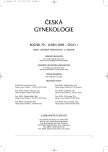Cystic Hypersecretory Carcinoma: Rare and Potentially Aggressive Variant of Intraductal Carcinoma of the Breast. Report of Five Cases
Authors:
A. Skálová 1,4; A. Ryška 2; K. Kajo 3; Z. Kinkor 4
Authors‘ workplace:
Šiklův patologicko-anatomický ústav LF UK, Plzeň, přednosta prof. MUDr. M. Michal
1; Fingerlandův ústav patologie FN a LF UK, Hradec Králové, přednosta prof. MUDr. I. Šteiner, CSc.
2; Ústav patol. anatomie LF UK a MFN, Martin, přednosta prof. MUDr. L. Plank, CSc.
3; Bioptická laboratoř, s. r. o., Plzeň, vedoucí prof. MUDr. A. Skálová, CSc.
4
Published in:
Ceska Gynekol 2005; 70(1): 73-78
Category:
Original Article
Overview
Objective:
To describe a poorly recognized histological and immunohistochemical features of cystic hypersecretory carcinoma of breast, including the overexpression of HER-2/neu protein and androgen receptors.
Subject:
Review of clinical and pathological features of 5 cases of cystic hypersecretory carcinoma.
Setting:
Private Bioptic Lab, Plzen and Department of Pathology, Charles University, Plzen.
Subject and Methods:
Five cases of rare variant of intraductal carcinoma of the breast, so-called cystic hypersecretory carcinoma, are reported. The patients were females aged between 53 and 78 years (average 66,8 years). The size of the lesions ranged between 7 and 8 cm in largest dimension.
Results:
In two cases, the development of high grade invasive ductal carcinoma was observed; in one additional case there was recurrence of high grade in situ carcinoma after three years. Strong overexpression of HER-2/neu protein was observed in three cases including those two with invasive component. Protein p53 was variably positive in all cases. Steroid receptor immunohistochemical study yielded variable results with only one case being positive for both estrogen and progesterone receptors. Interestingly, in most case (4/5) staining for androgen receptors was observed.
Conclusion:
The importance of correct diagnosis of this potentially aggressive lesion is emphasized. The differential diagnosis of breast lesions with predominantly cystic growth pattern is discussed in detail.
Key words:
breast, cystic ductal hypersecretory carcinoma, intraductal, in situ
Labels
Paediatric gynaecology Gynaecology and obstetrics Reproduction medicineArticle was published in
Czech Gynaecology

2005 Issue 1
Most read in this issue
- Abdominal hysterectomy – Risk Factor in Development of Urinary Incontinence? Results of a Questionnaire Study
- Risk Factors of the 3rd and 4th Degree Tear during Delivery
- Syndrome of Pseudomyxoma Peritonei – Description of Three Cases and Survey of the Problem
- Contribution of Doppler Examination in Pregnancy at Risk of Alloimune Fetus Anemia
